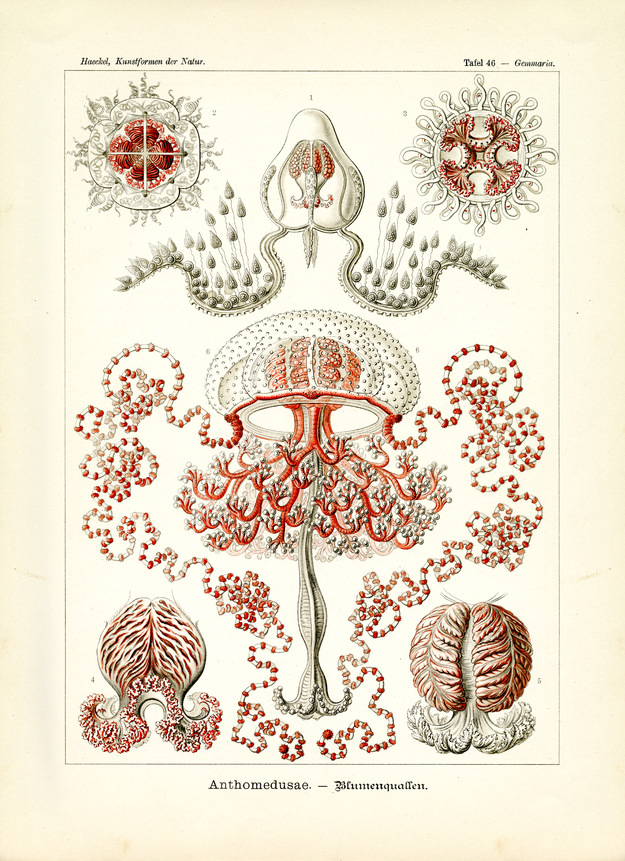Anthomedusae are distinguished from the other three orders of Craspedotae (plate 16, 26 and 36) by not having ‘hearing bubbles’ along the rim of the umbrella, but eyes instead (usually four or eight, often numerous eyes, usually of red or black colour). Sexual glands or Gonads (ovaries of females as well as ‘sperm-stock’ in males) do not develop along radial canals as it is the case with Leptomedusae (plate 36) and Trachomedusae (plate 26), but in the wall of the stomach cavity that hangs down from the base of the umbrella cavity. Gonads, with their content – eggs and sperms – being emptied freely into the sea water, usually possess a very delicate form, like feathered leaves (fig. 5 and 6), curled or net-shaped cushions (fig. 2 and 4) etc. The mouth tube, through which the stomach opens at the lower side, is at times prolonged into a trunk (fig. 6), usually split into four big, very tensile and flexible mouth lopes, delicately folded and puckered at the rim (fig. 3, 4 and 5). Some Anthomedusae furthermore possess tender, simple or branched oral arms carrying ‘nettle buttons’ at their free end; they at times originate from the mouth opening itself (fig. 2), at times from the base of the mouth tube or trunk (fig. 6). From the rim of the bell-shaped umbrella initially four tentacles or ‘capturing arms’ generate, that is, from the end of the four radial canals; frequently, however, two opposite tentacles form back with the other two being developed all the more stronger (fig. 1 and 6); their number later increases (fig. 2 and 3). Anthomedusae originate from Tubulariae (Röhrenpolypen, plate 6); until today they experience alteration of generation with these (Metagenesis). Out of the fertilized eggs of the free swimming, highly organized Medusae polyps develop, fixed and much simpler in their organization; they again produce Medusae through budding.
Translation of the original German introduction by Ernst Haeckel:
Phylum of Cnidaria (Nesseltiere); - subclass of Craspedotae (Schleierquallen); - order of Anthomedusae (Blumenquallen).
Translation by VR Translators Bangalore
This is one of the 100 pop science biology illustrations that were published from 1899 – 1904 in Leipzig by Ernst Haeckel through Verlag des Bibliographischen Instituts.
We've scanned the original lithography at 1200dpi on the Epson A3 scanner of A3 scanner huren. You can download a 400dpi JPEG here.
